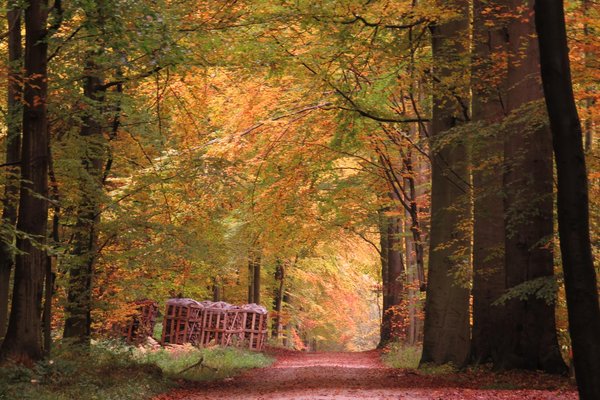Albania, Austria, Belgium, Bosnia Herzegovina, Bulgaria, Croatia, Czechia, France, Germany, Italy, North Macedonia, Poland, Romania, Slovakia, Slovenia, Spain, Switzerland, Ukraine
Primeval Beech Forests
The Ancient and Primeval Beech Forests of the Carpathians and Other Regions of Europe show the expansion and genetic adaptability of the European beech since the last Ice Age.
They comprise the largest remaining forests of the European beech (Fagus sylvatica) across 18 countries. They also hold the largest and tallest beech specimens in the world. The European beech is a very adaptable species spread across areas of different altitudinal zones, with different climatic and geological conditions.
Community Perspective: “I would like this beech forest madness to stop.” – this cry from Philipp seems to sum up the verdict on this WHS nicely; Caspar also shares some philosophical insights on the matter. But reviewers keep being drawn to its many locations: Vihorlat (Slova) – Els, John, Petteri, Matejicek; Stuzica (Slova) – Jarek, John; Hainich (Ger) – Hubert, John, Ian, Nan, Adrian; Kellerwald (Ger) – Peter, Clyde, Solivagant, John, Nan, Adrian; Grumsin (Ger) – Boj, Tsunami, Adrian; Jasmund (Ger) – Thijs, John, Michael, Matejicek, Nan, Tsunami, Adrian; Serrahn (Ger) – Adrian; Sonian Forest (Bel) – Els, Caspar, Adrian; Monte Cimino (Ita) – Matejicek; Foresta Umbra (Ita) – Matejicek; Bieszcziady (Pol) – Matejicek; Jizera (Cz) - Matejicek; Bettlachberg (Swi) – Philipp, Adrian; Mavrovo (NMac) – Chris, Le Grand Ventron (Fra) - Adrian.
Site Info
Official Information
- Full Name
- Ancient and Primeval Beech Forests of the Carpathians and Other Regions of Europe (ID: 1133)
- Countries
- Albania Austria Belgium Bosnia Herzegovina Bulgaria Croatia Czechia France Germany Italy North Macedonia Poland Romania Slovakia Slovenia Spain Switzerland Ukraine
- Status
-
Inscribed 2007
Site history
History of Primeval Beech Forests
- 2021: Extended
- To include 15 more locations in 7 countries
- 2017: Extended
- To include more forests in 10 countries
- 2017: Name change
- From 'Primeval Beech Forests of the Carpathians and the Ancient Beech Forests of Germany' to: Ancient and Primeval Beech Forests of the Carpathians and Other Regions of Europe
- 2017: Revision
- Includes former TWHS Monts Pollini (Italy 1982) and Umbra Forest from FTWHS Promontorio del Gargano (2002)
- 2011: Extended
- To include the Ancient Beech Forests of Germany.
- 2011: Name change
- From "Primeval Beech Forests of the Carpathians" to "Primeval Beech Forests of the Carpathians and the Ancient Beech Forests of Germany"
- 2007: Revision
- Beech forests of Havešová, Stužica, and Rožok were included in former Slovak TWHS Poloniny Vorgom Forests (1995)
- 2007: Inscribed
- Inscribed
- 2004: Requested by State Party to not be examined
- As "Primeval Forests of Slovakia"
- Type
- Natural
- Criteria
- ix
Links
- UNESCO
- whc.unesco.org
- Official
-
- cbr.nature.org.ua — Carpathian Biosphere Reserve, includes five parts
- sopsr.sk — Poloniny National Park, Stužica, Havešová, Rožok are part of the NP
- weltnaturerbe-buchenwaelder.de — Weltnaturerbe Buchenwälder
- Related
-
- nationalpark-kellerwald-edersee.de — Kellerwald-Edersee
- nationalpark-hainich.de — Hainich National Park
- mueritz-nationalpark.de — Müritz National Park
All Links
UNESCO.org
- whc.unesco.org — whc.unesco.org/
Official Website
- cbr.nature.org.ua — Carpathian Biosphere Reserve, includes five parts
- sopsr.sk — Poloniny National Park, Stužica, Havešová, Rožok are part of the NP
- weltnaturerbe-buchenwaelder.de — Weltnaturerbe Buchenwälder
Related Resources
- nationalpark-kellerwald-edersee.de — Kellerwald-Edersee
- nationalpark-hainich.de — Hainich National Park
- mueritz-nationalpark.de — Müritz National Park
- nationalpark-jasmund.de — Nationalpark Jasmund
- youtube.com — Video showing the forests scenery
- facebook.com — Photos throughout every month of the year of the Beech forests by Lukas Zemanek
News Article
- Nov. 4, 2017 bbc.com — Romania to investigate illegal logging in national park
- Aug. 25, 2015 spectator.sme.sk — Activists demand cutting Slovak Carpathian beech forest from UNESCO list
- June 26, 2011 dw-world.de — German beech forests declared World Heritage Sites
Community Information
- Community Category
- Natural landscape: Forest
Travel Information
Serial Transnational Sites
Red Zone Travel Advisory
Transylvania hotspot
Bilbao hotspot
Nancy hotspot
Berlin hotspot
Madrid hotspot
Tuscany hotspot
Western Bulgaria Hotspot
Rome hotspot
Brussels hotspot
Recent Connections
-
Golden jackal
Spotted in 2019 in Hainich NP
-
Red Zone Travel Advisory
Ukraine parts fully off-limits -
Drin Basin
Lumi i Gashit and Rrajca (Shebenik Jabl…
Connections of Primeval Beech Forests
- Geography
-
-
Alps
National Park Kalkalpen -
Drin Basin
Lumi i Gashit and Rrajca (Shebenik Jablanica NP) in Albania are within the Black Drin basin -
Carpathians
-
Mediterranean shore
Paklenica -
Pyrenees
Aztaparreta -
Situated on a Continental Divide
The main ridge on the Polish border is on the Continental divide (UNEP-WCMC) -
Baltic Sea
Jasmund National ParkSee en.wikipedia.org
-
In former GDR
German part is in the states of Mecklenburg-Pomerania, Brandenburg and Thuringia
-
- Trivia
-
-
On Euro coins
Commemorative 2 euro coin Germany 2024 shows Jasmund NPSee de.wikipedia.org
-
Furthest distance apart
Podilski Tovtry Nature Park to Hayedos de Picos de Europa is over 3000km. -
Depicted in Mizielinska Maps
Kalkalpen NP (Austria), Jasmund NP (Germany)See i.pinimg.com
-
Serial sites with the greatest number of locations
93 locations
-
- Ecology
-
-
Strict Nature Reserve
Partly: Strict nature reserve of Gashi River, Prašuma Janj strict nature reserve, Karpatskiy Biosphere Reserve and others (see link).See en.wikipedia.org
-
Beech Forests
European beechSee en.wikipedia.org
-
Peat
some peat in the valleys (UNEP-WCMC) -
Bears
brown bear (in Slovakia/Ukraine) (UNEP-WCMC) -
Bovines
bison (in Slovakia/Ukraine) (UNEP-WCMC) -
Gray Wolf
(in Slovakia/Ukraine) (UNEP-WCMC) -
Virgin Forests
contains the largest remaining primeval beech forests in Europe (AB ev) -
Desman
Hayedos de Navarra at Lizardoia and Aztaparreta. "Fauna:.......Pyrenean desman" -
Golden jackal
Spotted in 2019 in Hainich NP
-
- World Heritage Process
-
-
Extended more than once
3x (2011, 2017, 2021) -
Extensions on Tentative List
Poland, Bosnia-Herzegovina, Czechia, Italy, Montenegro, North Macedonia, Serbia, Slovakia and Switzerland -
Serial Transnational Sites
3 countries -
Derived from more than one TWHS
Poloniny Vorgom Forests and Primeval Forests of Slovakia (Slovak section) -
Minor modifications after inscription
2023: enlarging the Dürrenstein component part (Austria) to become Dürrenstein Lassingtal, and by merging the component parts Paklenica National Park – Suva draga Klimenta and Paklenica National Park – Oglavinovac-Javornik (Croatia) to become Paklenica National Park component part. -
Country gained extra WHS by an extension
2011 Germany, 2017 - Albania, Austria, Belgium, Bulgaria, Croatia, Italy, Romania, Slovenia, Spain, Ukraine, 2021 - Bosnia Herzegovina, Czechia, France, North Macedonia, Poland, Switzerland -
Inscribed on a single criterion only
ix. to be outstanding examples representing significant on-going ecological and biological processes in the evolution and development of terrestrial, fresh water, coastal and marine ecosystems and communities of plants and animals -
Already inscribed still on T List
Codrul secular Slatiora (forêt séculaire) (Romania); Central Balkan NP (Bulgaria) -
Extended
2011: To include the Ancient Beech Forests of Germany; 2017: To include more forests in 10 countries; 2021: To include 15 more locations in 7 countries -
Reduced from broader TWHS
The 2021 extension had several locations that were rejected or deferred (including an extension to Montenegro) -
Transboundary only
North Macedonia
-
- Human Activity
-
-
Royal Hunting Grounds
"The grand dukes of Mecklenburg-Strelitz were passionate about hunting and for this reason the forests around Serrahn are virtually untouched. Forestry use played a minor role. From a modern point of view a valuable and unique natural area was able to be created. " (Muritz NP)
-
- WHS on Other Lists
-
-
World Biosphere Reserves
Part of East Carpathians (1998), which also includes Polish territory -
IUCN Green List
Component - Sasso Fratino (Italy): The integral nature reserve of Sasso Fratino, in the heart of the National Park of the Casentinesi Forests, Monte Falterona and Campigna (2021) -
World Heritage Forest Programme
-
Natura 2000
See go4biodiv.org
-
- Timeline
-
-
Holocene
"Beech reached Western and Eastern Carpathian territory in an Epiatlantic period 5.000 years ago." (Nomination file, 2007, page 33) "Consecutively initiated from south to north, old forest habitats have been undergoing a development into extremely differentiated beech forest landscapes for some 6,000 years." (Nomination file, extension 2011, page 11)
-
- WHS Hotspots
-
-
Transylvania hotspot
Masivul Cozia : 80km / 2h by bus -
Bilbao hotspot
Picos de Europe -
Nancy hotspot
Grand Ventron (132km) -
Berlin hotspot
Grumsin (103km): " From Berlin main station (Berlin Hauptbahnhof) you can take the regional train RE3 to Angermünde (55min), departing every hour. There from May to October you can catch the WelterbeBus to Altklünkendorf (20min) and at the information point start your walking tour right away." -
Madrid hotspot
Hayedo de Montejo de la Sierra, Hayedo de Tejera Negra : 108km, best by car -
Hamburg Hotspot
-
Frankfurt hotspot
-
Bardejov hotspot
-
Tuscany hotspot
Sasso Fratino -
Linz Hotspot
-
Western Bulgaria Hotspot
Boatin Reserve: 127km -
Rome hotspot
Monte Raschio -
Brussels hotspot
Sonian Forest
-
- Visiting conditions
-
-
Free entrance
-
Red Zone Travel Advisory
Ukraine parts fully off-limits
-
- WHS Names
-
-
Named after a Tree Species
European beech (Fagus sylvatica)
-
News
- bbc.com 11/04/2017
- Romania to investigate illegal log…
- spectator.sme.sk 08/25/2015
- Activists demand cutting Slovak Ca…
- dw-world.de 06/26/2011
- German beech forests declared Worl…
Recent Visitors
Visitors of Primeval Beech Forests
- Adrian
- Adrian Turtschi
- Afshin Iranpour
- aleserre
- Alexander Barabanov
- Alexander Lehmann
- Alex Goh
- alicemears
- Alikander99
- A. Mehmet Haksever
- Ammon Watkins
- Ana Lozano
- Anna Wludarska
- Anne
- Argo
- Artur Anuszewski
- Ask Gudmundsen
- Aspasia
- Assif
- Astraftis
- a.thum
- Atila Ege
- BaziFettehenne
- Bill Maurmann
- Bin
- Boj
- bossc
- Bram de Bruin
- Brendan Carroll
- Bropyk
- butterflybird
- Can SARICA
- Carlos Sotelo
- Caspar
- Cezar Grozavu
- Cheryl
- ChrisDorn
- Christian Wagner
- Christoph
- Christravelblog
- Cirene Moraes
- Claire Bradshaw
- ClaraHH
- Clyde
- Colossus
- Cristina Erba
- Csaba Nováczky
- CugelVance
- czesioszpachelka
- Dagmara
- Damientournay
- dana144
- Dani Cyr
- Daniela Hohmann
- Daniel Chazad
- Daniel Gabi
- Dan Pettigrew
- David Berlanda
- David Marton
- DavidS
- debatecoach
- del
- Dimitar Krastev
- Dirk-pieter
- Dolemite92
- Don Irwin
- Dorejd
- Dwight Zehuan Xiao
- Echwel
- Eirini
- Elaine McArdle
- Elia Vettorato
- Elis
- Ellen Nielsen
- Elliot
- Els Slots
- emvcaest
- erdsaumnaht
- Erfe91
- Erik Jelinek
- Errol Neo
- Eva Kisgyorgy
- Evgenii
- fabi-ddorf
- Fan Yibo
- Farinelli
- Federico P.
- Feldhase
- Femke Roos
- Filip Murlak
- Filippo Ubaldi
- Flexiear
- Fmaiolo@yahoo.com
- forest80
- FrankW
- Frédéric M
- Frederik Dawson
- FS
- Galgalula
- Gary Arndt
- Geert Luiken
- George Gdanski
- GeorgeIng61
- Gernot
- Giannis75
- Hadrianus
- HaraldOest
- Harald T.
- Harry Mitsidis
- Hasco
- hdimoshi
- henrik_hannfors
- heywhatever2
- Highlander
- hotpickle
- Hubert
- Iain Jackson
- Ian Cade
- Ingrid
- Ivan Rucek
- Jakob F.
- Jakubmarin
- Jana and Matt
- Janina Lehmann
- janis
- Janos
- Jan-Willem
- Jan Zimmermann
- Jarek Pokrzywnicki
- Jasam
- Javier Coro
- Jay T
- Jean Lecaillon
- Jeanne OGrady
- Jeffrey Chai
- Jens
- Jesse S 2010
- Jezza
- J_neveryes
- JobStopar
- Joebobs
- Joel on the Road
- John Smaranda
- jonas
- Jonas Hagung
- Jonas Kremer
- Jonas Martinsson
- jonathanfr
- JoStof
- Joyce van Soest
- Juha Sjoeblom
- Jurre
- Justin Rickey
- KarenBMoore
- Karito Vies
- Kbecq
- KeithBailey
- KentishTownRocks
- Kerékgyártó
- Kevin247
- Knut
- Kurt Lauer
- La Concy
- Lado Joel
- Lara Adler
- leroykstlj
- Liamps91
- lichia
- Linneaaasaurus
- Lisu Marian
- Lithobates
- ljowers
- Loic Pedras
- Luboang
- Lucio
- Luis Filipe Gaspar
- Lukasz Palczewski
- lynnz317@aol.com
- Maciej Gil
- Mahuhe
- Małgosia Łupicka
- marcel staron
- marc Rouserez
- Marinemajor
- Marlies van Wolfswinkel
- Martin
- Martina Rúčková
- Matejicek
- Mateusz
- Mathijs
- Matthewsharris
- MatusBeber
- MaxHeAnouBen
- MaYumin
- MH
- M. Huineman
- Michael Ayers
- MichaelH
- michaelsballard
- Michael Turtle
- Mihai Dascalu
- Mikan22
- Mikko
- Miloš Tašković
- miri2808
- Mohboh
- Monica66
- MoPython
- Mstrebl1990
- Nafis N
- nan
- Nasebaer
- Nick M
- Nicole Lampos
- Nihal Ege
- nikolamus
- Olli-Pekka Turunen
- PabloNorte
- Paola Laura
- Patrik
- Paul Schofield
- peacemaker2142
- Peltzi
- Persian Globetrotter
- petar
- PeterA
- PeterH
- Peter Lööv
- Petri Jurescu
- Petteri
- pghgeekgrrl
- Philipp Leu
- Philipp Peterer
- phillipmeng
- Pieter Dijkshoorn
- Piotr Wasil
- PlacesWeHaveBeenTo
- Porcho
- Potsdamer
- pressdm
- Purrfect
- Rafał Kałczuga
- Ralf Regele
- Randi Thomsen
- Remigiusz
- Reza
- Riccardo Quaranta
- Rick Ohm
- rivr
- RobRos
- Rodinia
- Roel Sterken
- rogerding
- Roger Ourset
- Roman Bruehwiler
- Roman Raab
- Ronbon
- Rudegirl
- Sabrina Liebehentschel
- Samy G
- Schnitzel
- scubarrie
- Sebasfhb
- serghei.belous
- Shandos Cleaver
- shoaibmnagi
- Simonh
- SirLoydd
- Slavi
- sncjob
- Solivagant
- Stanimir
- Stanislaw Warwas
- Stefan A. Michelfeit
- stephanvermeulen
- stephhollett
- Stijn
- Svein Elias
- Szucs Tamas
- Taotao Chen
- Tarquinio_Superbo
- Tevity
- Thomas Buechler
- Thomas Harold Watson
- Thomas van der Walt
- Thorben
- Tim Allen
- Timonator
- Tom Flaten
- tommasorossotti
- Tonisan
- tony0001
- triath
- Truls Brekke
- Tschibi
- Tsunami
- Twobaconsandaboston
- UncleSlavi
- usagi1974
- Valentina
- ValiaVeweth
- Vanessa Buechler
- VB73
- Veronica
- Viaje al Patrimonio
- vino4vino
- VLabhard
- voyager
- WalGra
- wantrain.
- Westwards
- Wieland
- WILLIAM RICH
- Wojciech Fedoruk
- Wo_ko
- Xander Huang
- Xiquinho Silva
- YaroMir
- Yevhen Ivanovych
- zfish
- Zhenjun Liu
- Zizmondka
- Złoty Tłok Czesław
- Zoe
- Zoë Sheng
Community Reviews
Show full reviews
Hi everyone, this is my first review, so any comments are welcome. Reviews from other travelers have been helping me to plan my trips for the last two years, so I will be glad if my text inspires other peoples managing their own adventures.
For the last year I have been wanting to visit one of the beech forests of Europe, but it did not happen over several trips (the closest chance I got was during my stay in Brussels, but Christmas is not the proper time for forests!!!).
So when I was planning my trip by rented car from Zadar to Istria I realized that now it is a time to make stop in either Paklenica NP or Northern Velebit NP: both national parks are parts of both the UNESCO site "Primeval Beech Forests" and the UNESCO tenttive site "Velebit Mountain".
The entrance to Paklenica is located right next to the coastal road, so the choice was not difficult.
Just driving through the main (southern) entrance to the park and walking forth and back along the gorge stream seemed boring to me. So I studied the map in the brochure on the park website and found that I can get to the middle of the creek along the trail down the western slope. And by Google Maps I found a parking area not far from one of trails.
All I needed was to find (or make) a shortcut between the road and the trail.
Indeed, I have found a …
Keep reading 0 comments
This review is of Bulgaria's Dzhendema Reserve, which I hiked through without initially realizing that I would be in an UNESCO World Heritage Site.
My actual hiking goal was Bulgaria's tallest waterfall, Raysko Praskalo, which is located in Central Balkan National Park. Approximately 1.5 hours after starting the hike, I encountered a sign informing that I was entering an UNESCO World Heritage Site, which puzzled me as I had no idea that I was even in the vicinity of one. The mountain forest provided a very pleasant hike, but I would not have known about is specialness but for the sign. I believed that I hiked for about an hour in the forest before another sign informed me that I was exiting the UNESCO World Heritage Site.
After another 15 minutes of hiking, I arrived at Rai Hut, where lodging and hearty food are available. The mountain waterfall is just beyond the Hut, and I thought the waterfall - which is not part of the UNESCO World Heritage Site - was worth the hike that required moderate to medium exertion. I am not sure if the actual UNESCO World Heritage forest alone would have been worth the hike, but the forest did contribute to the joyfulness of the hike, so I certainly am not going to complain (Well, I could perhaps complain, as I had a nasty trip while I was in this UNESCO World Heritage Site, which resulted in a permanent 8 cm-long scar on my shin).
… Keep reading 0 comments
Le Grand Ventron, September 2024
The Vosges mountain range in Alsace turns out to be surprisingly, well, mountainous, with steep cliffs, large boulders, and hair pinned mountain pass roads, which came as a little bit of a surprise to me, having grown up in the Alps myself, and expecting more of a landscape with gentle slopes and undulating hills.
I’m no tree expert, but the beech forests around the Grand Ventron mountain peak seem to owe their existence to a very specific local micro-climate. – Whereas the Vosges mountains themselves are generally fully covered by fir trees, the composition of the forest suddenly changes as you approach the top mountain ridge – quite abruptly, firs give way to beeches, but only so on the eastern side of the crest. This phenomenon can be nicely observed from the Promontoire Vosges-view point a little bit up from popular Col De la Schlucht mountain pass.
Meaning, of course, in order to visit the beech forests of Le Grand Ventron, you need to hike close to the top of the mountain ridge in a north-south direction, but on the eastern side only. This is confirmed by looking at the map of the core zone, which consists of a narrow strip of maybe some 7000 by 400 meters. – Too bad, then, that the Grand Ventron-hiking path goes along the western side of the ridge only, where there are lots of fir, but essentially no beeches. Hiking outside marked paths along the …
Keep reading 0 comments
Visit: 4th of sept.2024,Serrahn
I took the train from Berlin-Suedbahnhof at 07.36am via Berlin-Hauptbahnhof(central station) and Berlin-Gesundbrunnen to the city of Neustrelitz, where I arrived at around 09.00am. I walked from the train station to the city center and looked around the pleasant city for a bit. About 1.5 hours later I took the bus 619 from the Neustrelitz bus station, which is right in front of the train station. I got off the 619 bus at the stop "Zinnow World Heritage Site”. Everything is excellently signposted from there...I didn't need my downloaded offline map.
I decided to take the main trail("naturlehrpfad") from Zinnow to Carpin. It was a sunny day with quite high temperatures.I had bought two bottles of water in the city of Neustrelitz which turned out to be a good decision as the only cafe inside the forest was closed to the public that day. As soon as I entered the forest the temperatures were more bearable as you immerse yourself in a shady world of trees,The path was pleasant, flat, easy to walk and very well maintained....no cars or bicycles allowed on the nature trail....bicycles are allowed on other trails through the beech forest, but no cars.
I hiked to the park information center in the hamlet of Serrahn, where there is a cafe (only open Friday to Sunday), an old building with nature photos on display, the unmanned information center itself with toilets, stuffed animals and information boards about the beech forest …
Keep reading 0 comments
Valle di Lodano, August 2024
Valle Maggia is a large alpine valley in Ticino, the Italian-speaking part of Switzerland, extending some 60 kilometers from Locarno to the north towards the Gotthard Massif, which forms the watershed between the North Sea and the Mediterranean. Many smaller side valleys extend from Valle Maggia, one of which being the Valle di Lodano, which forms part of the larger Valli di Lodano, Busai and Soladino forest reserves. Unusually, the flanks of the valleys in this part of the Alps are covered not by conifers such as firs or spruce but by broadleaves – mainly beech, extending from the floor of the valley almost all the way up to the mountain ridges.
From Lodano the mountains rise dramatically into the sky, creating an almost surreal atmosphere of raw, “primal” nature. Lodano itself has a split personality: the picturesque old village of typical rustici, traditional local buildings made from unplastered granite stones – this is where the tourists live – and a modern new town (new village) next to it where the locals live. The village is connected to Locarno, a major transportation hub, by super-regular (every half hour) buses which plow the length of Valle Maggia.
The village makes the most of its UNESCO-designation, with multiple informative panels introducing the history and significance of the protected alpine beech forest. However, some care must be taken, as these panels show the protected area (“Buffer zone (protection)” in the nomination file), and not …
Keep reading 0 comments
Sonian Forest, May 2024
The Sonian Forest is a small 2-km2 property in Flanders located on the south-eastern outskirts of Brussels – all that remains of what used to be a much larger forested area going all the way to the Ardennes. Pretty much all of it was chopped down over time, including some trees ending up – rather uselessly – for building Napoleon’s never-carried-out English invasion fleet.
A Flemish-only UNESCO forest would not work in the complex dynamics that is the non-country (to quote the rather infamous former MEP), hence two smaller pieces along both sides of a busy road to the north in the Brussels-Capital Region as well as two really tiny areas on the other side of a major highway to the south in Wallonia were added to balance things out nicely.
I started my hike on a Sunday morning at 6:30a at stop Foresterie, where helpful bus 17 drops you off, coming from metro station Beaulieu that connects you with Brussels center. The two Grippensdelle areas (forming the northern end of the core zone) lie on both sides of a through road, which was surprisingly busy even at this early hour. The car traffic along with the constant noises of airplanes starting from nearby Zaventem made me wonder if the little plaque I noticed at the forest entrance alerting wanderers to be mindful of Bambi deer in spring was maybe not a tad optimistic. At any event, the only wild animals I saw …
Keep reading 0 comments
Bettlachstock, October 2023
Bettlachstock lies on the southern slopes of the Jura – the lesser known of the two parallel mountain ranges crossing the country diagonally (with the Mittelland plane lying in-between, where the majority of the Swiss population lives). Bizarrely, the official UNESCO nomination files talk about Forêt de la Bettlachstock, even though Bettlachstock forest lies squarely in the German-speaking part of Switzerland (the country takes its language borders very seriously).
The core zone is located around 500 meters above the Mittelland plane. Avoiding what must be a strenuous ascent I started my hike from bus stop Bettlachrank on line 38 which runs from Grenchen further up the mountain all the way to Unterer Grenchenberg (a popular weekend spot with a nice view and restaurant).
I like to start my walks at dawn in order to have the chance to spot some animals – this time I saw a chamois (I did not expect to see them at these still relatively low altitudes, but the terrain is quite rocky and steep, and hence they apparently like this area – also, with the forest being protected, maybe they are safe here from being hunted?), a fox, and just a quick passing shadow from what appeared to be either a marten or a weasel. As it was too early for the bus to already operate at this time I had pre-arranged for a taxi to pick me up at Grenchen Süd train station – a stop on the …
Keep reading 0 comments
Kellerwald, August 2023
Kellerwald is situated in a very rural, bucolic area set against gently undulating hills around 90 minutes by bus and / or train to the west of Kassel, the transportation hub on the main north-south German ICE line.
The northern, more accessible part snugs gently against Edersee, a sinuous dammed lake dotted with many sailing boots on sunny week ends. The southern part of the core zone is more difficult to reach and would take more time to explore than I had.
I overnighted in Korbach, a Holzfachwerk-picture-perfect little town on the northern side of the forest, easily reachable by hourly train from Kassel. The recent influx of refugees has visibly augmented the local shopping and food options. Public transport in the area is excellent, and I was presently surprised to see that the town offers a bus as early as 05:30 on a Sunday morning to Harbshausen village on the north-western end of Kellerwald forest (call ahead for prebooking a day prior). It turned out the bus was actually a taxi (local bus fare rates still apply, though), and for a small tip the friendly cabby agreed to drive me right up to Wanderparkplatz “Himmelsbreite” at the very edge of the forest.
Shortly after the parking lot the core zone starts, and I proceeded to walk up to Ringelsberg which rewards with a scenic view onto the hilly forested landscape against the backdrop of Edersee in the valley below (see picture). …
Keep reading 0 comments
Jizera Mountains, July 2023
Giant boulders dot the landscape of Jizerské Hory, the Isergebirge of lore, making for rather spectacular hiking across an impressive landscape located in northern Bohemia, close the Czech-Polish-German tripoint
I’ve spent the night in Hejnice, a small town well-connected by hourly trains to lively Liberec, the nearest transportation hub. Hejnice lives off tourism and maybe the odd pilgrim visiting the rather grand church dedicated to the Blessed Virgin, with an old Franciscan monastery attached next to it. Sadly, the monks are long gone, but the monastery offers basic but absolutely acceptable accommodation in a peaceful setting, save maybe for the quarter-hourly ringing of the bells which I did not mind at all. In the old refectorium tasty local cuisine is being served. The hostel has a very useful free map of the area with all the trails, a blow up of the official 1:25000 map which is also sold in local bookstores and the main tourist office back in Liberec. The area around Hejnice is popular with local day trippers, mainly for cycling and hiking; hence expect plenty of visitors even early in the day.
Right behind the monastery the Jizera Mountains Beech Forest rises up dramatically into the sky. Shortly after dawn I took the main “red” trail which serpentines steeply and rather strenuously some 350 meters up to Ořešník viewpoint, rewarding you with great views of the forest-covered mountain landscape and the valleys down below. Ořešník is a very craggy mountain …
Keep reading 0 comments
Jasmund Beech Forest, June 2023
Jasmund National Park Beech Forest is situated on the homonymous peninsula on the north-eastern coast of the island of Rügen, facing the Baltic Sea. Jasmund is known for its ancient beech trees - some of these trees are estimated to be around 700 years old and reach heights of up to 40 meters - stunning natural scenery, and rich biodiversity.
What makes the landscape so extraordinarily beautiful and uniquely attractive are the famous (Caspar David Friedrich!) white chalk cliffs of Rügen, rising dramatically from the Baltic Sea, with the beech forest located on a plateau some 100-150 meters towering above, extending right to the very edge of the cliffs, with various intermittent viewing points offering breathtaking vistas of the Baltic Sea.
I took the path from the popular little seaside resort of Sassnitz to the Königsstuhl National Park Center, which runs along the edge of the cliffs from south to north. The cliffs rise up and down quite a bit, with small gorges breaking the landscape, hence the trail takes somewhat longer to walk than I originally expected. There are also some paths which cross the forest in an east-west-direction, taking you deeper into the heart of forest; however, as I was facing intermittent (and at one point forceful) rain, I did not explore further.
According to the park’s Web site Jasmund is home to a rich diversity of flora and fauna. Myself, I noticed various kinds of ferns and mosses, …
Keep reading 0 comments
Hainich Beech Forest, June 2023
A bear! – I was stopped dead in my tracks this early morning in June suddenly spotting a rather large dark animal some 5 meters up a beech tree close to the trail, apparently looking at me. I somewhat panicked and proceeded to quickly leave the scene. What at this moment appeared to be a small bear must have been, of course, reflecting on the encounter a bit later in more calmness, just a racoon, its white stripes obscured by the dimness of the forest in the early hours. Small vindication, then, that at least in the German language a racoon is called a Waschbär, hence, at least lexicologically, a kind of bear.
Hainich is a rather large and diverse forest, located next to Wartburg-famous Eisenach in Thuringia, a stop on the major ICE route from Berlin to Frankfurt. Different from other beech forests in Germany, the core zone (some 15 km2) is easily accessible, well crisscrossed by many paths and even some gravel roads, certainly in the southern part of the area, a bit less so in its north-eastern parts. It even seems possible to visit parts of the core zone on horseback (horsing is quite popular in this part of the country). The area used to be part of a larger Soviet military training area, and some areas are cordoned off due to unexploded ordnance; but this may just be a tactic to scare off potential visitors (I heeded the …
Keep reading 0 comments
Serrahn Beech Forest, June 2023
Serrahn is a small beech forest, UNESCO-inscribed in 2011, which forms part of the larger Müritz National Park in Mecklenburg Western Pomerania, around 90 minutes north of Berlin. The wider area, dubbed by the local tourist board as "the land of a thousand lakes", centered around lake Müritz, the largest inland water body in Germany, is partly hilly but mostly flat, shaped by the last Ice Age, sparsely populated and mainly covered by forests, lakes and marshes, and these days popular for all kind of recreational activities, including hiking in the woods.
Neustrelitz is the nearby transportation hub, with very regular trains to Berlin. Bus 419 connects Neustrelitz with Zinnow, from where the main hike through Serrahn forest starts, which is a 2-hour walk (more of you take detours, see below) ending in Carpin, passing via homonymous Serrahn hamlet (population: less than 10). On weekends, morning bus services are limited, but taxis are available in Neustrelitz (call a day ahead).
The 2.7 km2 large very pretty core zone is almost fully beech trees. The ten-times larger (and still pretty, but less impressively so) buffer zone is more diverse, including spruce, pine, and oak trees. This being Germany, the main hike from Zinnow to Carpin is set up as a Waldlehrpfad (nature trail), combining recreation with education, with informative little signposts along the trail, informing hikers about the history, flora, and fauna of the region.
For fauna, I encountered a group of …
Keep reading 0 comments
Even though I had been to all WHSs and TWHSs in Germany, upon learning that Germany was offering a 9-Euro, monthly train pass in summer 2022, I decided to take advantage of it and to visit the north-east corner of the country, where I had hardly travelled before, for about 10 days. As such, the final destination for this trip was the Jasmund National Park, which includes the Primeval Beech Forests WHS.
I took a bus from the Sassnitz Busbahnhof straight to Königsstuhl National Park Centre.
At the NP Center I first checked out the multimedia exhibition with an automatic audio guide, which, as you might expect, did not work very well. On the other hand, the 20 min. movie playing continuously titled "Migration of Ancient Beech Forest," produced around the time of its inscription in 2011, was quite good and informative, I thought.
In the early afternoon there were 2 walking tours of the NP, one for families with children and the other for the little more serious-minded. So I decided to join the latter. It turned out that I was the only participant, and the guide, a park ranger, did not speak much of English. My German is certainly not good enough. So what do we do? Consequently, because the first tour had 2 guides, both of whom spoke decent English, one of them decided to join my tour because this woman, not from the UNESCO office but from the German office that takes care …
Keep reading 0 comments
Grumsin Beech Forest, June 2022
The forest can be visited as a half-day trip from Berlin via public transport. As other reviewers have pointed out the actual UNESCO-listed property is “verboten” to be visited on your own – there are paid official guided tours available, which require pre-booking well in advance. There are four official signposted hike trails which pass through the buffer zone and touch the borders of the core forest areas, but do not enter or cross it.
Even though Grumsin is close to Metropolis Berlin the area of the forest is very rural and the main access road to the little hamlet of Grumsin proper (half a dozen of farmhouses) is shockingly rough for a country like Germany. The wider area used to be the hunting grounds of the Brandenburg princes of lore, then followed by the clique around Goering (the remains of the Carinhall estate are nearby), and finally the red barons of the GDR stalked their deer and wild boars there, which may explain why the area remains relatively underdeveloped and relatively untouched. Even today, hunters’ high seats abound in the area.
With the UNESCO listing of Grumsin came change to the community around the forest – what used to be a quiet backwater now is being heavily marketed by local and regional tourist boards. Apparently, nobody asked the locals if they had an opinion, and the UNESCO listing came as a surprise (and shock) to many. Around Grumsin there are a …
Keep reading 0 comments
This is a hard site to rate: There is no doubt at all that these areas should be protected. But this site has been so "successful" with its many extensions that it has kind of ridiculed its on OUV: How can a site have OUV that has 82 locations in most European countries? The locations are so numerous that nobody can still consider unique so it would actually only be consequent to remove the site from the list! It implies the strong question how many locations a serial site can or should have (I couldn't answer this question in respect to the Compostela sites though I think definitely that a much stronger selection would improve the sites). To me it seems that serial sites and especially those with a long list of locations are increasing on the Unesco list and this seems to imply almost always a mediocre or weak site. To select one example pars pro toto (as the Nuragic momuments) or of a few outstanding examples (such as the Begijnhofs) seems the better way to go.
The second drawback of this site is the visitor experience and once more I am amazed how a site which offers obviously little excitement to most visitors has such a high rating on our website (similar to the Limes sites which seem rather crappy apart from Hadrians Wall). In the meanwhile we have even two of those forests in Switzerland and I had once even hiked around Bettlach but I am …
Keep reading 0 comments
Summer holidays with my son ticking of all that Macedonia has to offer and a bit of Albania. Of course with the Beech Forest listed for 2021 (I think it should) I wanted to go as we wanted to make some hikes anyway. UNESCO gives coordinates N41 45 06 E20 35 23 for the center. Good for me and it has 168ha with a 200ha buffer zone. I made it to about 200 meters from N41 45 06 E20 35 23 as it was exactly on a slope so couldn't reach it.
How to get there? It's the REAL wilderness of Macedonia and the area is home to bears (we did see fresh tracks in the mud!!!), wolfs etc and not without risk if you don't know what you do. I decided to have a local hiking guide with me so we would be with 3 people rather as just 2 plus he had enough knowledge about the area. Even he, hadn't been there often. There is actually just 1 trail which is possible and it starts in Ribnica (small village but nobody is there anymore). It goes to the summit of Ribnicka Skala and passes the coordinates mentioned by UNESCO for the Beechforest. It's a 8km one way trail. It is marked, but, partly very dense vegation and no way to see a path. Finally I didn't make it to the summit (secondary objective) due to rain.
The forest was beautifull pristine. Lots of flowers. Butterflies. Some …
Keep reading 0 comments
The beech forests of Germany are a continuous running gag in my family. Both my father and my uncle pick this site when they want to point out that something is fishy about world heritage sites. Now, you need to know that neither of them knows much about world heritage sites. But they do know a bit of beech trees, having run a tree nursery specialising in German beech trees for most of their adult lives. And they aren't really impressed about this site, at least the German component. And I think I get why.
The designated areas in Germany are all National Parks, but .. Germany is densely populated. You simply won't find huge, rugged areas of virgin forests in Germany. It's limited patches of forest, intercut by roads or trails and close to villages. Civilization is never that far off and it makes it hard to appreciate the OUV of the German component.
So far, I have managed to see three forests in Germany: Kellerwald, Hainisch and Jasmund. If I was to pick, I would single out Jasmund for the best visiting experience due the iconic scenery of Cape Arkona, the white cliffs of Rügen. Forest wise though, none of the national parks impressed me.
Getting There
The Kellerwald visitor center is accessible via rail from Vöhl-Herzhausen. Major town nearby is Kassel.
From Bad Langensalza or Eisenach, you can take an infrequent bus to the Hainich visitor center. Next major town nearby is …
Keep reading 0 comments
Adding a beech forest to the long list of inscribed beech forests seems to be the easiest way to get a new WHS in Europe. Switzerland also wants a piece of this cake and added two beech forests to its tentative list. I visited one of them, the Bettlachberg forest during the coronavirus lock down weekend. The forest is easy to reach by car. It’s just a few minutes outside Grenchen and there is a road leading right into the forest. We parked our car next to the street and hiked up to the old castle ruin of Grenchen, within the forest. It’s a rather easy uphill hike. Doable in less than one hour and really fun on a sunny day. In the end it is just a forest and it is heard to gasp the OUV. But I have the same problem with the already inscribed parts, so why not. On a positive note, there were lots of beech trees. Much more than I saw in the forests in Bulgaria or Italy. On the other hand, it is not a virgin forest. It is clearly maintained like any other forest in Switzerland.
It will probably be inscribed one day. I, personally, am against it. I would like this beech forest madness to stop. Further, Switzerland has with Corbusier and Pile Dwellings already too many of these underwhelming multi national WHS. The forest is only for hardcore collectors, but can easily be combined with Berne and La Chaux-de-Fonds/Le Locle.
Keep reading 0 comments
COMMENT TO EXTENSION (SLOVAK and POLISH COMPONENT)
I am sorry, Els. I cannot help myself and have to add further comments on the planned extension to the WHS Ancient and Primeval Beech Forests of Europe. The news that the ultimate extension of this WHS is going to happen made me very happy. It would be very strange world, where Sonian forest is the part of this beautiful WHS but fine beech forest in Poland and Balkan region are not. I am also happy that Bieszczady component (Poland) is included this time (unlike in 2017) as well as the forests of Czechia, Slovakia, Bosnia-Herzegovina, France, Italy, Switzerland, Serbia, Montenegro, and North Macedonia.
The Polish component comprises of ca. 11-% of National Park area. One of the parts is shown in the photo - This is the view from the Slovak-Polish border close to Kremenec hill towards Bieszczady mountains. After extension, the entire trans-national range of Slovakia, Poland and Ukraine will be protected as WHS site.
WHS in the area: the church of Smolnik, part of Wooden Tserkvas of Carpathians
Keep reading 0 comments
SLOVAK COMPONENT - EXTENSION
I am very happy to see that the sad story regarding Primeval beech forests WHS of Slovakia is coming to an end!!! I commented it in more detail in my review to the corresponding WHS.
After more than 10 years, Slovakia state party will propose modifided nomination that should be in line with the WHS standards - it means sufficient protection, clear boundary and legal status, etc.. The existing sites will be re-nominated with modified boundaries and buffer zones (Havešová, Rožok and Vihorlat components will remain; Stužica-Bukovské vrchy component will be cut into two pieces: Stužica and Udava), and another component Kyjovský prales will be added. I have not yet visited the additional component. It has special regime because it is a part of military area with restricted access. I was ca. 3-5 km from the Kyjovský prales only... but not directly there yet. Despite the special regime, it is possible to visit the area. The schedule is published on-line. What I know, this somponent is of perfect quality and protection. Thus, it is excellent candidate to enrich this WHS.
I include the photo of Carpathian blue slug (Bielzia coerulans) from Stužica-Bukovské vrchy component. I am happy to know that creatures like this will be finaly protected by highest possible level.
Updates, February 2020 (more than 12 years after firts nomination of the Slovak components):
My enthusiasm towards the substantial border modification slightly faded, but I am still happy anyway...
…
Keep reading 0 comments
CZECH COMPONENT
Extension approved in July 2021! and I am very happy with this. From beech forests I have visited/seen, the Slovakia/Ukraine/Poland cluster + Foresta Umbra in Italy + the Czech component are all beautiful and deserve the WHS status.
Thus, five stars again to beech forests!
------------
I re-visited the site in June 2021 just before the realease of the IUCN evaluation. It was an uncomplicated day trip from Prague (excellent bus connection to Liberec, and then to Oldřichovice v Hájích by local train - there are marked trails uphill to the site: National Natural Reserve Jizera Mountains Beech Forests). I must say that I was pretty impressed by the quality of the forest and its ecosystem I found at the site. Several parts of this component have very similar character to the sites in Carpathiens. Nevertheless, they are at the same time very different because of the difference in geology.
The Natural Reserve and its buffer zone (all together ca. 2000 ha) encompasses almost 17 km long range and I walked around/through at least half of it during my last visit. Only the parts around Poledník Mt. (PHOTO) and Štolpichy canyons (444 ha) are proposed as the core zone, and the rest is planned as the buffer zone. The strength of the site lays in its size and diversity. Even though no genuine virgin forest survived there, quite large parts have very natural character (the core zone) and the entire site has very …
Keep reading 0 comments
POLISH COMPONENT - BIESZCZADY
Bieszczady mountains NP in Poland is popular tourist destination, and no wonder why. The national park is simply beautiful and I take it as quintessential Carpatian mountains. Due to the depopulation after WWII, the area is not affected by utilitarian pressures as it can be found on Slovak side, which is already WHS.
I comment it in my review to WHS Primeval Beech Forests:
It certainly deserves WHS status. It is more touristy and maybe not so wild as forests on Slovakia part. Due to a bit higher attitude there are large poloninas (mountain meadows) on the mountains ranges, which are very attractive and worth-visiting as well (although poloniny area itself is not part of proposed WHS). I also admired forest management that is 1000-times better than in official WHS of Slovakia. Only shadow on my optimism concerning Polish contribution to this WHS lays in unclear politics in Poland nowdays. Therefore, the nomination was withdrawn by state party in 2017 in spite of high qualities of Polish component, which would be perfetly complementar to sites in Slovakia and Ukraine. I am afraid that it is somehow related to issue in Bielowieza forest, and Polish side wants to avoid "problems" with UNESCO in case of controversial management in forests.
The extension is planned for 2020, we will see...
Keep reading 0 comments
COMPONENTS of SLOVAKIA, GERMANY and ITALY
I really love this WHS and spent quite a lot of days&nights in beech forests mostly of Slovakia components. Paradoxically, I am not surprised by low ratings of other travellers, since it is not easy to recognize qualities of this WHS. Though this huge transnational property looks a bit odd and quality of individual comonents is hardly comparable, if it results in better protection of beech forest it makes me very happy. In my case it was love at first sight, and as true love it has its ups and downs. To be clear: the entire ecosystem of primeval beech forests is simply amazing and fascinating, sadly, this is not definitely true for several state parties and even their NGOs (ego of NGO) that should take care about WHS...
Visited sites:
(1) Slovakia - they have incredibly valuable naturale heritage in these WHS components, but even after 10 years after inscriptions the state party of Slovakia has not been able to decide what belongs to the component and what not, because there are huge discrepancies between reality and official proposal. The worst thing is that the strict protection has been declared in the nomination text, but reality is completely different - only certain parts of WHS are sufficiently protected by law. Unfortunately, almost nobody form Goverment, Municipalities, and local people carred about this problem in the past. Even NGOs attitude and action were problematic in my opinion. In the past and …
Keep reading 0 comments
Although I had been to the Heinrich National Park before, I stopped at the Grumsin area of the MAB Reserve in September 2017. Both are part of this Primeval Beech Forest WHS in Germany (as well as in 11 other countries).
A bus from Angermünde dropped me off right in front of the WHS Info Center in Altkunkendorf, but this 30 min. public bus ride that went around the most rural area I have ever seen in the state of Brandenburg was like a roller coaster ride and is highly recommended.
The couple at the Info Center was extremely helpful and recommended me to take a combination of two color-coded hiking trails in the area during the 5 hours I had there.
But the trails only go around the core zone, and the couple had told me that it was prohibited to walk into the core zone (as it is in the Shirakami Mountains Beech Forest WHS in Japan). Although I saw several trails that branched out into the core zone without any prohibiting signs, I didn't bother walking in, as all beech trees looked like the same to me.
But because I had only driven through the Heinrich NP, this leisurely hiking, breathing the O2 emitted by the WH beech trees, was a much nicer experience.
Keep reading 0 comments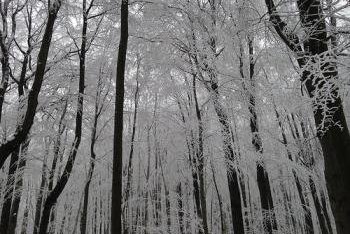
Driving out to Hainich I apologised to my wife, "I think I have gone too far with this one." The calm non-vocalised acceptance indicated I had indeed probably overstepped the mark a little.
By this time our car was weaving on the deep snow atop the single track road outside the village of Craula and I had already started budgeting for how much the recovery vehicle would cost to haul us out. But we made it to the small car park at the entrance to the WHS core zone parked up and hoped that we would be able to get out again.
A thick white blanket wrapped the whole landscape as the deep snow blended seamlessly with the heavy skies when I jumped out of the car and donned my coat, scarf and gloves.
"It's ok you go do your thing, I'll take some photos around here and stay warm." said my wife, again cementing her role as the sane one in our relationship.
So off I trekked, not really planning on getting far, just hoping I could find something that I could comfortably identify as being a beech tree. It didn't take me long, as a few hundred meters from the car park were the tall thin black stalks of trees. Snow and ice clung to the dark wood of the leafless trees which were set against powdery grey skies and made the whole scene a glorious monochrome tableau.
There was utter silence as I gawped at the spectacle, …
Keep reading 0 comments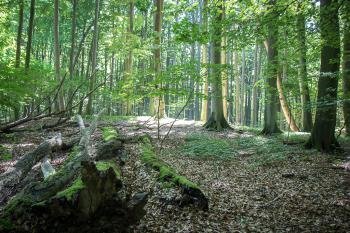
All five of the protected areas in Germany offer a variety of experiences. From the white cliffs and coastal breeze of Jasmund National Park through to the inland mountain ranges of Kellerward-Edersee National Park.
There are hiking trails and recreation facilities in all the parks and some of them have modern and informative visitor centres with detailed information about the remaining beech trees and the forests that once covered the country.
One of the best information centres is at Jasmund National Park – and this is the one I visited. It has an excellent video presentation and a detailed museum with facts and figures about the forests. There are also guided tours and talks from local experts.
Keep reading 0 comments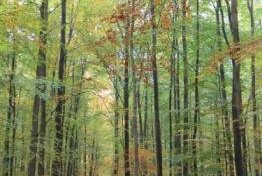
The Sonian Forest near Brussels is proposed as an extension to the Primeval Beech Forests of The Carpathians and ancient beech forests of Germany. If all goes well, this is scheduled to materialize in 2017. The extension proposal is a trans-border series consisting of 33 components, located in 11 State Parties: Albania, Slovenia, Romania, Italy, Poland, Austria (in the lead), Croatia, Bulgaria, Ukraine, Spain and Belgium. This in addition to the current WHS that already covers 15 beech forests in Slovakia, Ukraine and Germany.
The listed Primeval Beech Forests represent pure and mixed stands of European Beech in various environmental conditions. One wonders if so many more examples are really necessary. The nominating countries are serious about it though, and have developed a classification system defining Beech Forests of Regions (BFR) in Europe. Each BFR is characterized by specific climatic conditions and flora, and demonstrates an individual piece of history of the beech forests.
The Sonian Forest is the only remaining beech forest in the Atlantic climate zone. It marks the western limit of the species range in Europe. 74% of the forest area is covered with beech, part of the scattered remains of the ancient Silva Carbonaria or Charcoal Forest. The Sonian Forest furthermore has nice trivia value as its area covers parts of all three regions of Belgium: Flanders, the Brussels-Capital Region and Wallonia. And it would be another addition to the already extensive Brussels WH Hotspot.
I feel a bit bad about my first visit to a …
Keep reading 0 comments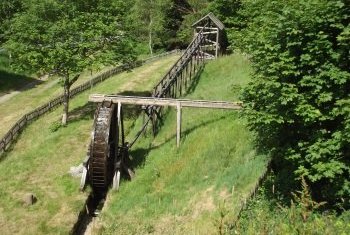
With the exdtension of this WHS to include some German beech forests, I have now visited three of these.
Of them the Jasmund National Park on Rugen Island was the most spectacular, where the forest appears to tumble down the cliffs to meet the Baltic Sea. I reached the Park HQ at Konigsstuhl by bus #20 from Sassnitz station and enjoyed the comprehensive audio-visual displays at the HQ.
The Kellerwald National Park had many hiking trails on offer, of different lengths and grades. I reached the park from Kassel on bus #555 travelling one way via Frankenberg and returning via Korbach.
I also visited Thiemsburg in the Hainich National Park, travelling on bus #27A from Eisenach station. The main attraction here seemed to be the Baumkronenpfad, a walkway through the forest canopy.
Keep reading 0 comments
The "easiest" way to see the inscribed area within Vihorlat is to hike up to Sninsky kamen, which is just within the core area, and which offers panoramic views of the overall protected area within Vihorlat. The hike up to Sninsky Kamen starts from Morske Oko, which in turn can be reached by driving to the end of the road from Remetske Hamre (around 20km from Michalovce). Morske Oko seems to be a somewhat popular tourist location (at least for locals) as the site features a car park, signposted trail markers, and there also were several people strolling around the lake. The trail up to Sninsky Kamen, on the other hand, is less popular even if being relatively easy (with the exception of some missing trail markers). In fact, the main challenge is to reach Vihorlat in the first place as the park is located closer to Ukrainian border (only Ukrainian mobile network provider was occasionally within range inside the park) than any major Slovakian city.
In terms of sights, the descriptions of the sights within the other reviews seem rather well fitting also for Vihorlat. The forest areas are rather thick and pristine, with the best areas located close to the peak (and hence the inscribed area). As the area is quite far from large cities and relatively undisturbed by human visitors, the site also offers possibilities for spotting wildlife (managed to spot a fox and a small deer during my visit).
All in all, an area well worth …
Keep reading 0 comments
Jasmund National Parks is on Rugen. My ferry from Sweden was along Jasmund National Park so I really enjoy watching closer to Konigsstuhl and the part of the Jasmund National Park. There was also blue/ green water at this unique park. Stena Line has ferry service between Trelleborg, Sweden and Sassnitz, Germany daily. I should to visit this park in the next time but on foot in this park.
Keep reading 0 comments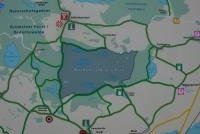
Berlin-based travelers can easily visit the Grumsin Forest in one day. The closest train station to the park is Angermünde (about an hour from Berlin Hauptbahnhof). Buses run hourly from there to Altkünkendorf town. The new visitor center in Altkünkendorf provides information on hikes, trails inside the forest.
Walking inside the forest is quite an experience, the type you read in German fairy tales. The forest is dark; some areas do not get sunshine.
Keep reading 0 comments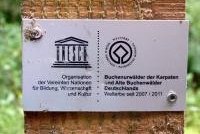
When choosing which of the 5 German Beech forests to visit we looked for one which was reasonably close to our main route for other WHS and gave us the chance definitely to enter the inscribed area with a hike of 1-2 hours from a roadhead. It came down to 2 – Hainich which is north of Eisenach and therefore convenient for a visit to the Wartburg and Kellerwald-Edersee which is west of Kassel and therefore convenient for a visit to the Bergpark.
It is worth noting that in the case of all 5 WHS inscriptions the inscribed area is significantly smaller than the National Park or Reserve within which they are situated. The inscribed area will have been chosen because it contains the most significant primary growth forest - inevitably that tends to put it in the centre of the Park/Reserve which will also encompass secondary growth areas which will probably contain areas of modern re-planting or re-growth.
We homed in on Kellerwald-Edersee where its northern inscribed boundary is, for a kilometer or so, contiguous with that of the NP at the point where it flanks the Edersee itself. On the drive in it is possible to pick up a reasonably detailed map of the NP at Information Centres - perfectly adequate for a hike following a named trail. The UNESCO inscribed area is clearly differentiated from the NP on this map by green “hatching”. Some German road maps show a “white” road going all the way along the …
Keep reading 0 comments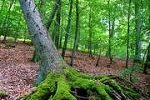
I visited the Kellerwald-Edersee National Park in Germany and spent a great day hiking around the primeval beech forest. Minimal human intervention occurs in the national park which means that trees are left to grow freely. I encountered several beech trees that fell naturally and were completely taken over by wild mushrooms, moss, ferns and other vegetation. The Kellerwald Information Center was my starting point, with interesting informative leaflets, videos and hiking maps for free! Plenty of parking free of charge too! The easiest route (Hagenstein) turned out to be quite rewarding and I spotted the splendid Red Kite, Black Kites, and a woodpecker. There are many species of beetles to be found and interesting flora too. I hope to visit other sites in other countries to be able to compare between them, nonetheless the Kellerwald-Edersee Park surely deserves to be inscribed in the list.
Keep reading 0 comments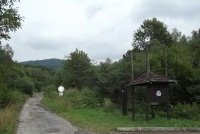
The local people in eastern Slovakia do not understand the interest in their trees; they have been surrounded by them for millenia. But having these forests protected for the future is priceless.
I felt a certain ownership of this WHS as I had attended the meeting in Christchurch when the site was first listed in 2007. I was reminded of this each time I inspected a National Park information board. I visited two parts of this site :
Vihorlat : I reached the end of the road in Zemplinske Hamre by bus from Snina, the same spot that Els reached. I crossed a bridge and found a few marked tracks into the forest, but without the benefit of a trail map did not follow them very far.
Stuznica : this part of the Poloniny National Park is accessed by bus from Snina to Nova Sedlice. From the bus stop a track continues past the National Park office up the corner where Slovakia, Ukraine and Poland meet.
Keep reading 0 comments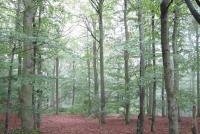
In July 2011 I planned a long weekend Germany. After my visit to the Fagus Factory (Alfeld) I drove to the Kellerwald NP. The Kellerwald is part of the Primeval Beech Forests of the Carpathians and the Ancient Beech Forests of Germany. Kellerwald is inscribed in July 2011. I arrived late in the afternoon and decided to visit first the Kellerwald information centre. The centre is build in 2008 and easy to find at the edge of the parc. The building is very nice and I paid 6 euro for the little exhibition about the wildlife inside the parc. The information is totally made with computergraphics. Also at the end they showed a 3D-movie about the parc.
The visit to the centre is a good start before the hiking. Free maps with the trails are available at the desk of the centre. I went to my hotel at the other side of the parc, near the Wildtierparc (animalparc). That was a ride of almost 40 minuts along the Edersee. Beautiful !
The next day it was raining and cold, not really perfect for a good hike. The trails where slippery and muddy . So...I changed my plan and decided to go up with the cable train (standseilbahn). In 10 minuts I was 300 meters higher into the forest. First I walked to the viewpoint and later I walked a little bit on different trails.
Kellerwald NP is easy to visit. There are a lot of trails (difficult and easy). The …
Keep reading 0 comments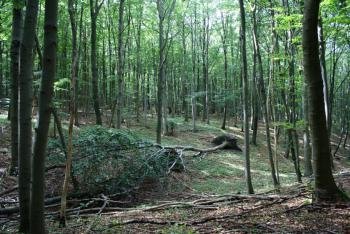
In 2009 I visited Hainich national park, one of the five german properties that extend the Carpathian beech forrest WHS in 2011. It is easy to get there, the park is at the motorway A4, very close to the Wartburg castle in Eisenach. The nominated area is the core zone of the park and represents about one-third of the entire national park. I first went to the information center „Thiemsburg“ and asked which of the many marked trails will give the best impression of the area nominated for WHS. A very nice man at the information recomended the „Sperbersgrundweg“, a 6 km loop walking trail, that starts at the car park „Craulaer Kreuz“. He was very exited about the upcoming WHS nomination and explained to me that is a major difference between the German and Carpathian forests that they are located at different heights. The three sites in the north-east of Germany are at sea level, Hainich and Kellerwald are in the lower highlands (200 to 600 m above sea level), and the Carpathian forests are above 1000 m sea level. I'm not an expert in botany, so that I can not judge whether this warrants the inscrption. For me it was just a forest, certainly a beautiful forest. Beeches are large and amazing trees and I really enjoyed my walk through the forest. But it is just a forest. For those who think of Grand Cayon or the Jungfrau Protected Area in the Alps as an natural WHS, would …
Keep reading 0 comments
Basic info about Slovakian part only. Stuzica Reserve is the only easy accessible part of Heritage (with marked footpaths). Havesova and Vihorlat are located in remote part (if you have good map you can go there but there are no roads), Rozok is close to Ukrainian border with a road passing through but its not a marked footpath.
Stuzica in Slovakia is somehow similar to Bialowieza Forest, not in type of flora but as the area of no human activity. All fallen trees stay as they are the whole area is big enough to host big mammals, there are no paved roads inside the reserve. Two marked footpaths are the only way to get there.
Keep reading 0 comments
In preparation for my visit, I had a difficult time finding any practical information about the nominated properties in Slovakia. My guidebook has nothing of any value on them but does include a handy map called 'Snina wooden churches' that covers the same area. The IUCN evaluation holds a shady map, which seems to point out only 3 properties on the Slovak side instead of 4. A better bet for maps is the Slovak/Ukrainian nomination dossier. I also found a regional website that has information about villages and parks. It describes access to the Vihorlat Protected Landscape via the village of Zemplínske Hámre. So I turn this route into the goal for myself today, possibly (weather and other circumstances permitting) with a walk to Morské Oko lake.
On the road eastward from Kosice, I quite suddenly encounter a sign 'Morské Oko' (near Remetské Hámre) - which is the lake on Mt. Vihorlat. I drive on (foolhardily), determined to give the other side of the mountain a go. The closer I get to the Ukraine border, the more dense the soft green-coloured forest gets. Especially the area around Ubl'a is very scenic. Here I also find two villages with domed Orthodox (or Eastern Catholic?) churches. Finally, I arrive at 'my approach' to Vihorlat: Zemplinkske Hámre. Its streets are filled with churchgoers, who stare at me, the outsider. I drive all the way to where the road ends ... and then there's nothing! Well, this is where the mountain starts but …
Keep reading 0 comments
